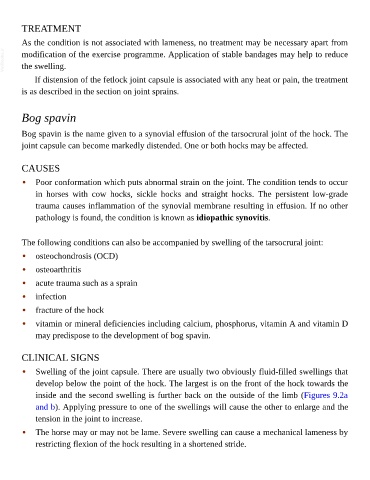Page 408 - The Veterinary Care of the Horse
P. 408
TREATMENT
As the condition is not associated with lameness, no treatment may be necessary apart from
VetBooks.ir modification of the exercise programme. Application of stable bandages may help to reduce
the swelling.
If distension of the fetlock joint capsule is associated with any heat or pain, the treatment
is as described in the section on joint sprains.
Bog spavin
Bog spavin is the name given to a synovial effusion of the tarsocrural joint of the hock. The
joint capsule can become markedly distended. One or both hocks may be affected.
CAUSES
• Poor conformation which puts abnormal strain on the joint. The condition tends to occur
in horses with cow hocks, sickle hocks and straight hocks. The persistent low-grade
trauma causes inflammation of the synovial membrane resulting in effusion. If no other
pathology is found, the condition is known as idiopathic synovitis.
The following conditions can also be accompanied by swelling of the tarsocrural joint:
• osteochondrosis (OCD)
• osteoarthritis
• acute trauma such as a sprain
• infection
• fracture of the hock
• vitamin or mineral deficiencies including calcium, phosphorus, vitamin A and vitamin D
may predispose to the development of bog spavin.
CLINICAL SIGNS
• Swelling of the joint capsule. There are usually two obviously fluid-filled swellings that
develop below the point of the hock. The largest is on the front of the hock towards the
inside and the second swelling is further back on the outside of the limb (Figures 9.2a
and b). Applying pressure to one of the swellings will cause the other to enlarge and the
tension in the joint to increase.
• The horse may or may not be lame. Severe swelling can cause a mechanical lameness by
restricting flexion of the hock resulting in a shortened stride.

